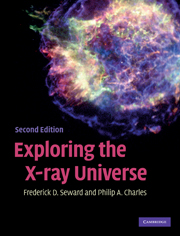Book contents
- Frontmatter
- Contents
- List of acronyms
- Foreword
- Chapter 1 Birth and childhood of X-ray astronomy
- Chapter 2 X-ray emission and interaction with matter
- Chapter 3 Tools and techniques
- Chapter 4 Solar system X-rays
- Chapter 5 X-ray absorption and scattering in the Interstellar Medium
- Chapter 6 Active stellar coronae
- Chapter 7 Early-type stars
- Chapter 8 Supernova explosions and their remnants
- Chapter 9 Neutron stars, pulsars, pulsar wind nebulae, and more supernova remnants
- Chapter 10 Cataclysmic variable stars
- Chapter 11 X-ray binaries
- Chapter 12 Black-hole X-ray binaries
- Chapter 13 Normal and starburst galaxies
- Chapter 14 Active galactic nuclei
- Chapter 15 Clusters of galaxies
- Chapter 16 The diffuse X-ray background
- Chapter 17 Gamma-ray bursts
- Index
- Plate section
Chapter 2 - X-ray emission and interaction with matter
Published online by Cambridge University Press: 05 June 2012
- Frontmatter
- Contents
- List of acronyms
- Foreword
- Chapter 1 Birth and childhood of X-ray astronomy
- Chapter 2 X-ray emission and interaction with matter
- Chapter 3 Tools and techniques
- Chapter 4 Solar system X-rays
- Chapter 5 X-ray absorption and scattering in the Interstellar Medium
- Chapter 6 Active stellar coronae
- Chapter 7 Early-type stars
- Chapter 8 Supernova explosions and their remnants
- Chapter 9 Neutron stars, pulsars, pulsar wind nebulae, and more supernova remnants
- Chapter 10 Cataclysmic variable stars
- Chapter 11 X-ray binaries
- Chapter 12 Black-hole X-ray binaries
- Chapter 13 Normal and starburst galaxies
- Chapter 14 Active galactic nuclei
- Chapter 15 Clusters of galaxies
- Chapter 16 The diffuse X-ray background
- Chapter 17 Gamma-ray bursts
- Index
- Plate section
Summary
Astrophysical mechanisms for generating X-rays
There are three radiation processes – thermal, synchrotron and blackbody – that are the dominant mechanisms for producing X-rays in an astronomical setting, and whenever high-energy electrons are present, we must add inverse Compton scattering of microwave background photons into the X-ray regime. The spectral signature of each process is unique and is therefore one of the first clues to the nature of an unknown X-ray source. If the spectrum can be measured with high resolution over a broad energy band, then usually both the emission process and the physical conditions within the source can be deduced.
Thermal emission from a hot gas
Consider a hot gas of low enough density that it can be described as thin and transparent to its own radiation. This is not difficult to achieve for X-rays. At temperatures above 105 K, atoms are ionised, and a gas consists of positive ions and negative electrons. Thermal energy is shared among these particles and is transferred rapidly from one particle to another through collisions. Indeed thermal equilibrium means that the average energy of all particles is the same and is determined only by the temperature. When an electron passes close to a positive ion, the strong electric force causes its trajectory to change. The acceleration of the electron in such a collision causes it to radiate electromagnetic energy, and this radiation is called bremsstrahlung (literally, ‘braking radiation’).
- Type
- Chapter
- Information
- Exploring the X-ray Universe , pp. 12 - 17Publisher: Cambridge University PressPrint publication year: 2010



